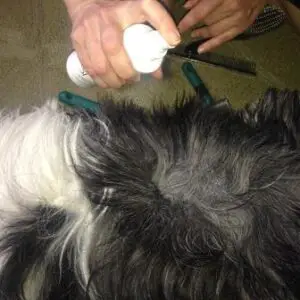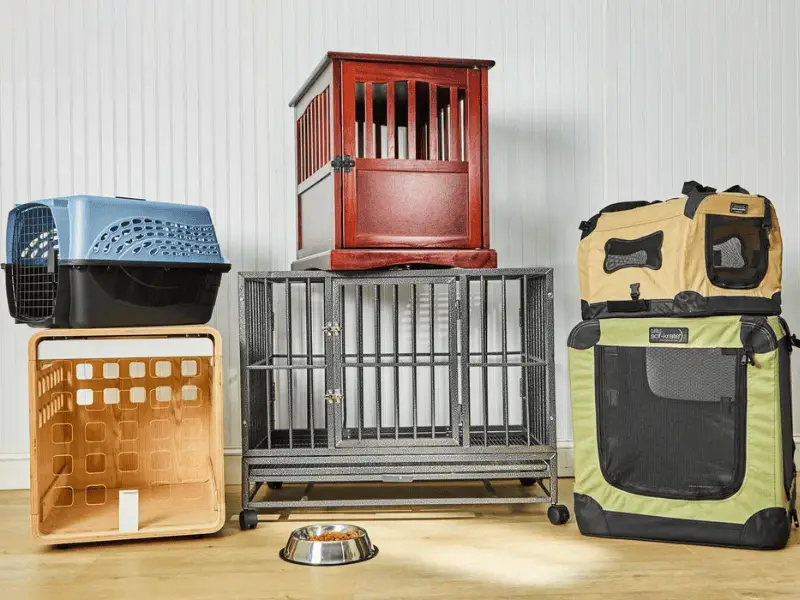Many dogs have issues with getting their fur tangled. Dematting and treating severely matted dog hair can be frustrating and time consuming.
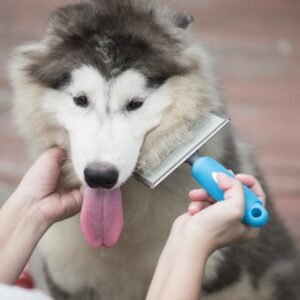
This is especially true for long haired dogs such as Havanese, Maltese, Shih Tsu, and some Terrier breeds.
How To Treat Severely Matted Dog Hair
If dog hair doesn’t get brushed regularly, this can result in mats.
You should regularly use a deshedding brush and maintain your dog’s coat with daily brushing or regular brushing, depending on the fur type.
This will go a long way in helping you avoid wrangling with difficult mats.
So what should you do when you realize your dog’s fur is matted? First thing to do is make sure you have the right dematting tool and assess how badly your dog’s fur is matted.
Also consider the weather or season is outside.
Perhaps it’s winter and you’d rather keep your dog’s fur longer for protection from the elements.
If it’s summer you and your dog might be better off to take him to get professionally groomed by a dog groomer to have a short haircut and grooming.
If you think this is something you could tackle and your dog can handle the dematting process, then here are our tips and suggestions:
1. Dematting will probably take a few sessions

We do not recommend you try to treat severely matted any dog hair type all in one session.
Depending on the severity of the matted fur, it may make more sense to take a few days to properly demat your dog’s coat.
Of course, your groomer has a certain skillset and will do it in one session, but that probably explains why my dog hates going to the groomer.
To keep the peace with your dog, I would break up the dog grooming sessions.
2. Make sure you have the right dematting tool
We highly recommend a grooming kit that includes:
- Dog dematting comb
- Regular dematting brush
- Slicker brush
- Stainless steel comb (e.g. Fine/Coarse Steel Greyhound Comb)
I use these various dog dematting tools on my Havanese.
You may need more than just grooming tools, you might also consider getting some detangling spray made for dogs.
Top Three Choices for Dematting
Check out our post on Dog Grooming Tools – For an overview of must have grooming tools including the top deshedding tool and dematting rake options for different hair types, and highly recommended undercoat rake selections.
How to deal with stubborn mats
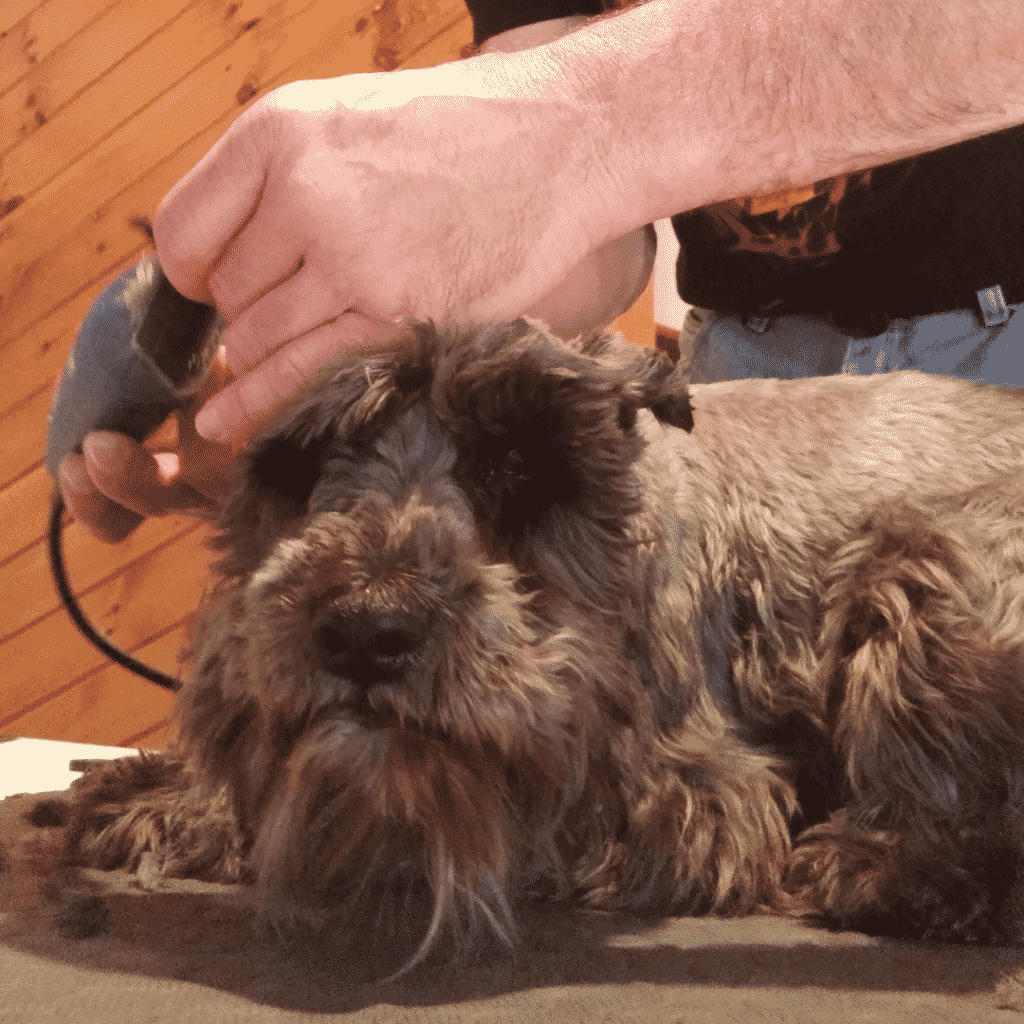
When you have tge right dog dematting tool in hand it’s the difference between wrangling with stubborn mats, especially if your dog has long fur and sensitive skin.
Stubborn mats are when the fur appears to tied in knots and simple combing won’t release the knot.
It is essential that
- dog hair rakes
- dog mat breaker
- dog dematting conditioner
- dog detangler comb
If you find mats that are particularly stubborn, try using a de matting comb or brush with dematting conditioner for dogs. Start at the ends of the mats and gently work your way up.
Use any dog dematting tool with care and be careful not to pull on the fur or skin.
If your dog is resistant to de matting, try using a little detangling spray while gently combing the ends firt with a de matting tool to help loosen the hair.

3. Have dog treats ready
Some dogs are more sensitive than others. Some dogs enjoy grooming and others don’t. Regardless, dematting can hurt your pet’s skin at times.
We recommend that you have your dog’s favorite treats on hand so you can reward him throughout the grooming session.
If you give your dog treats and praises, you are training him that grooming is a rewarding process.
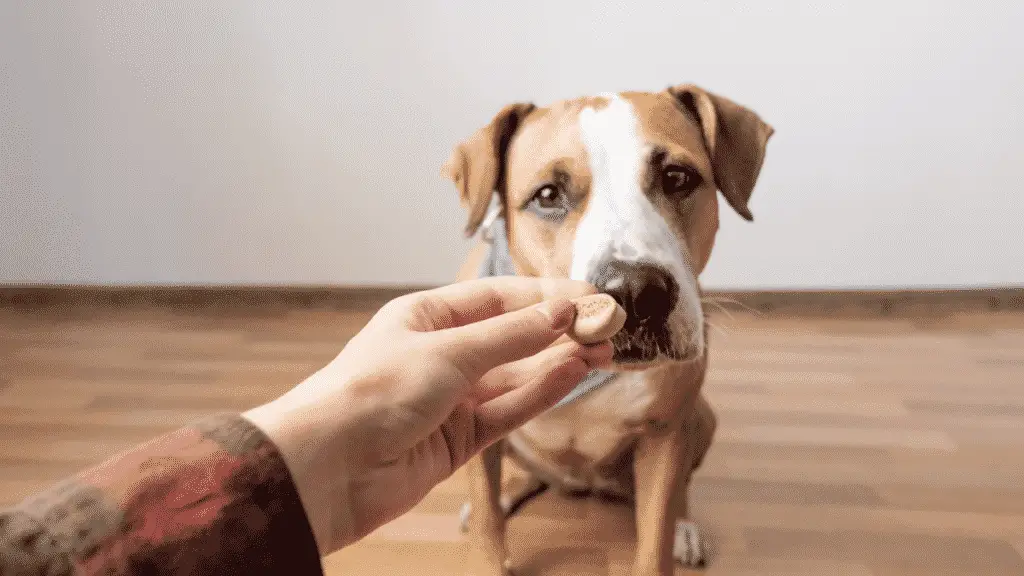
4. Determine where you will conduct the grooming session
I would recommend a place where your dog is comfortable, but can’t easily escape. I groom Kobi in our living room on a high countertop.
He’s comfortable enough because it’s the living room, but it’s also high enough that he won’t jump down and escape.
Have all of your de matting tools right in front of you before you start so you can keep the process moving and keep your dog comfortable.
5. Is your dog dirty?
If your dog needs a bath, definitely do this grooming before you do a dematting session.
It’s going to be more work and take more time grooming your dog if you have to extract both dirt and hair mats.
Sometimes it might be easier to try to demat your dog right after a bath, but it really depends on their fur/hair and your dog’s personality. My dog goes a bit nuts after a bath so it’s not a great time to groom him.

6. Lightly brush your dog’s coat all over his body
It might help to use some detangling spray before you brush your dog’s fur, but it really depends on your dog’s fur.
When you’ve completed this step, you’ll know how badly your dog hair is matted and where the problem spots are.

7. Plan your dog grooming session by segmenting problem spots of your pet’s hair into various sections
For example, with my dog I typically break up the areas I need to work on as follows:
- Ears – matted hair near the opening of the ear canal, but my dog loves to have his ears/ear area brushed
- Tail – less sensitive and easier to brush out because the hair is coarser
- Belly – super sensitive, but often not that matted
- Chest – can be really matted, but less sensitive than belly
- Paws – not typically that matted, but he hates to have his paws touched
- Underarms – probably not the scientific name, but hopefully you understand. This is where you’ll find a LOT of matting. Unfortunately for Kobi, this is also a sensitive area.
Dog Anatomy – What part of your dog needs grooming?
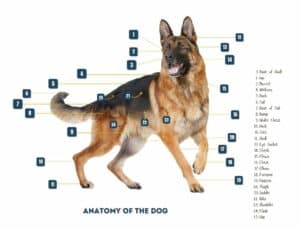
Your dog may have different areas that are very sensitive, less sensitive, or matted. Regardless, break up the list of “to do” areas – you don’t want to tackle all the sensitive areas at once.
8. Where do you start?
Some groomers and breeders state that you should start at the bottom and basically create a line in the dog’s hair and work your way up.
We find that to be really time consuming and doesn’t really take into consideration where your dog’s sensitive spots are.
For example, our dog Kobi would freak out if we started at the bottom of his belly or paws which are his super sensitive areas.
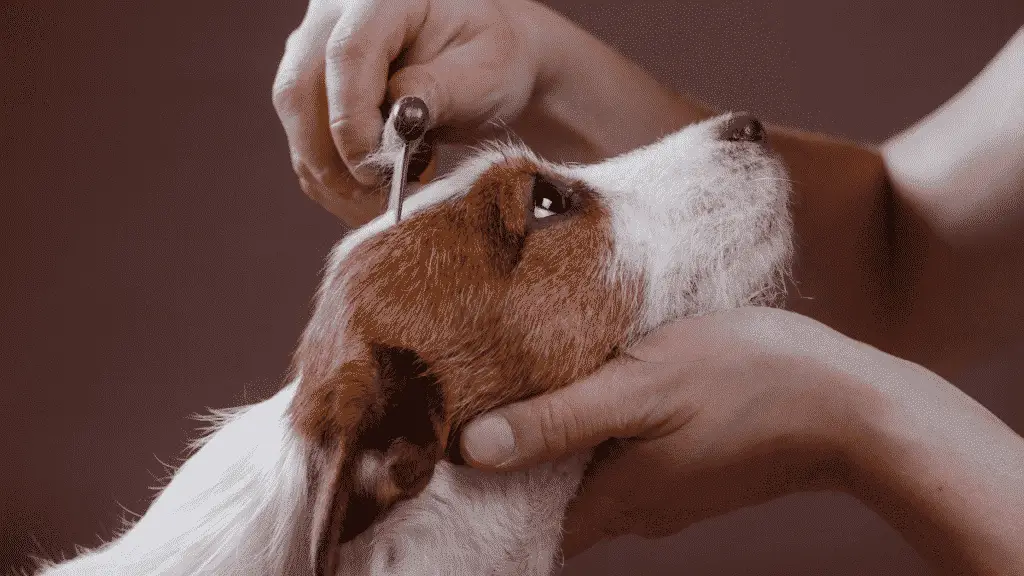
As such, we recommend starting where your dog is less sensitive and enjoys being brushed (for Kobi it would be his ear area).
After you have addressed all of the less sensitive areas, vary the dematting between sensitive and less sensitive spots. This includes spots that are easier to brush and more difficult.
9. How to brush your dog’s hair? Which de matting tool should you use?
Any person that has had relatively long hair will understand the golden rule that you don’t pull hair (or fur).
If there is a tangle, you need to hold the hair at the root (so it doesn’t hurt) and then brush or comb through the tangle.
This is also the golden rule when it comes to brushing and dematting your dog.
Spray detangling spray on matted areas
Dead and Loose Hair
Matted dead hair or loose hair that easily gets matted can be troublesome for all hair types.
When there is dead fur wrapped in difficult mats pet parents will not only need to detangle but gentle remove the dead hair with a de matting comb.
Get the right dematting tool for the job
De matting tools like a double sided comb with stainless steel blades and an extra wide head are essential. Also look for:
- dematting rake
- comfortable gel
- undercoat comb
Pretty much, any dematting tool with stainless steel teeth and rounded edges is essential to remove mats easily. Especially for long haired dogs.
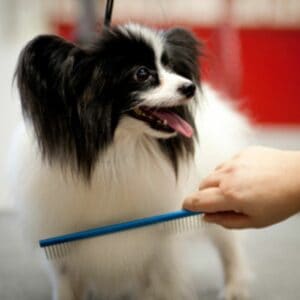
Long-haired dogs
Long-haired dogs may be more prone to developing mats, which are clumps of tangled hair that can be difficult to remove.
Mats can cause pain and discomfort for the dog, and they can also lead to skin infections.
Another reason why long-haired dogs may be more difficult to groom is that their hair may be more likely to shed.
More about dematting comb teeth
Make sure the dematting rake teeth of any de matting comb used is well spaced to accommodate different types of coats – long coats or double coats.
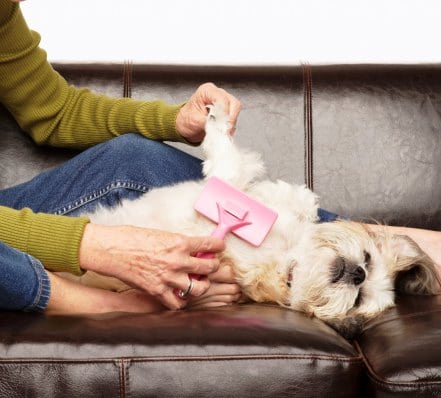
Look for a dematting rake / dematting tool with rounded ends which serve to protect your dogs sensitive skin from sharp blades.
Whatever tool you select, it should have better than average customer ratings and can accomplish multiple grooming jobs: detangling, deshedding, and undercoat removal.
One popular brand with rounded edges is the Gopets dematting comb.
Light combing
As mentioned before, first start with an overall light combing instead of brushing. Don’t force any tangles with your de matting tool.
Consider using detangling spray. Then do your mental break up of your dog’s body and problem areas and assess what would be easiest to start with.
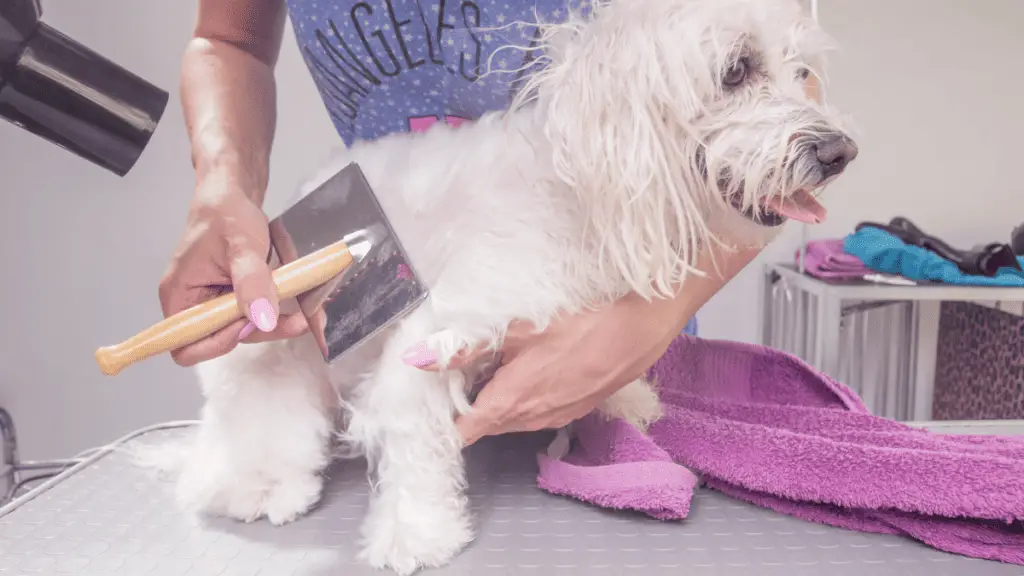
Personal experience dematting a Havanese
For example, I’ll start combing Kobi’s ears with the greyhound comb using the wider prongs.
When I get to a matted area, I’ll hold his hair at the roots/base and then use the dematting comb.
When our dog Kobi has relatively few tangles around his ear area, then I’ll switch to using the fine stainless steel blades on the de matting comb before using the slicker brush or other brushes.

What is a Double Coat?
A double coat is a type of fur that consists of two layers: an undercoat and an outer coat.
The undercoat is short, soft, and dense. The outer coat is long, coarse, and stiff. This type of fur helps protect dogs from the elements. A Golden Retriever has a double coat and a big dog like the German Shepherd is another breed with a double coat.
If you have a dog that has a double coat, dematting can be a bit more difficult.
You will need to use a special dog dematting tool (or comb) to cut through the tangled fur. Be very careful not to cut your dog‘s skin while dematting.
You may also want to try using a special dog shampoo or your dog’s coat is severely matted, it is best to take him to a professional groomer.
Groomers have the proper pet supplies and experience to know which is the best dematting tool to handle stubborn mats quickly and safely.
Three easy steps for dematting dog hair
- Insert dematting comb with rounded edges into the matted dog hair
- Hold hair at the roots
- Pull away from the dog
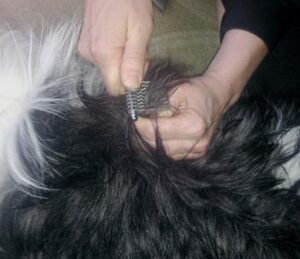
When using the dematting comb, it’s easier to start with a smaller area of the matted fur.
Hold the base of the hair and then put the prongs in the matt, sharp edges away from the dog and then pull away from the matt and your dog.
If you properly hold your dog’s hair, it will not hurt them.
If it’s a really large mat, start with a smaller area of the mat using the dematting comb and intermittently use the slicker brush which will help take out the matted hair leaving you a cleaner and easier smaller mat to tackle.
Remember to hold your pet’s hair at the root/base as much as possible so you don’t pull their fur.
To the left is an example of us taking out a mat from Bootsie – a very cute Tibetan Terrier.
10. Break up the locations where you are grooming, brushing, and combing your dog
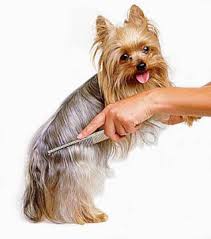
I typically use a stainless steel comb with rounded edges and start with Kobi’s ears and head.
Next, I will brush or comb his back which is sensitive but generally doesn’t have too many mats. I’ll ignore any mats that might be on his back and move on to his tail.
Afterward I’ll go back to a matted area on his body, then back to the other side to an unmated area. In between zones, I’ll make sure to give dog treats and verbal approval (i.e. “good dog”).
Also, make sure you continually get rid of dead hair that will accumulate in the comb.
The first time you do this with your dog, you might want to set a time limit (e.g. 10 mins). You can repeat the process each day until your dog’s coat is dematted.
Does matted hair hurt dogs?
There is no definitive answer to this question, as matted hair can potentially cause a variety of issues for dogs – from skin irritation and infection, to difficulty breathing and even problems with movement. If your dog’s hair has become matted, it is best to consult with your veterinarian to determine the best course of action. In some cases, the mats may need to be shaved or cut out, while in others, regular brushing and grooming may be sufficient to prevent further matting.
Dog collars that don’t mat hair?
Now that we’ve shared some of the best products that can help reduce matting – from special brushes and combs to coat-conditioning sprays, there is one thing that is often not so obvious.
Your dog’s collar may create problems and you will want to find dog collars that don t mat hair.
There are a variety of different types of dog collars that can mat dog hair, including cloth collars, buckle collars, and martingale collars. It is important to choose a collar that does not add to the problem of matting, as this can cause discomfort and lead to further hair loss.
Some of the best options for dog collars that don t mat hair include those made from smooth materials such as
- leather
- nylon
- rounded design
You should also avoid collars with spikes or other sharp edges, as these can damage the coat and lead to matting.
Round Up
There are a few things you can do to prevent mats from forming in the first place. First, make sure to brush your dog’s hair regularly – at least once or twice a week. This will help loosen any dirt or debris that could become caught in the hair and lead to matting.
You can also use a dematting dog shampoo after a coat-conditioning spray before brushing to help detangle the hair and make it easier to brush through. Finally, be sure to choose a dog collar that doesn’t add to the problem of matting – smooth materials such as leather or nylon are best, and avoid collars with spikes or other sharp edges.
Final Tips
The problem with dog hair is that it can cause mats and tangles. Dog matting isn’t just a cosmetic issue for dogs; their coat may become matted, which leads to skin problems!
Grooming an animal whose entire body has been covered in knots all over can be uncomfortable for them and is a hassle for any dog owner.
When it comes to keeping your dog’s coat looking its best, there are a few key tools you’ll need in your arsenal. Dog hair rakes are great for removing loose hair and debris, while a dog mat breaker can help loosen mats and knots.
A dog dematting conditioner can also be helpful in keeping your dog’s coat healthy and free of tangles. Finally, a detangling comb can help work out any remaining knots and tangles.
FAQs
Dog hair dematting meaning
The term “dematting” is used to describe the process of removing mats from dog hair.
What causes dog mats?
Mats can be caused by a variety of factors, including dirt, dust, and debris getting caught in the hair, as well as lack of regular brushing and grooming.
What is the best method to dematt a dog’s hair?
Dematting can be done manually using a special dematting tool, or with the help of a professional groomer.
What’s the best way to prevent mats in your dog’s hair?
The best way to prevent matting is to brush your dog‘s fur regularly (at least once a week) and to trim any long or shaggy hair that is prone to tangling. If you are unsure of how to properly groom your dog, consult with a professional groomer or your veterinarian.
Read More: Small dog breeds
ALSO READ


